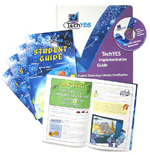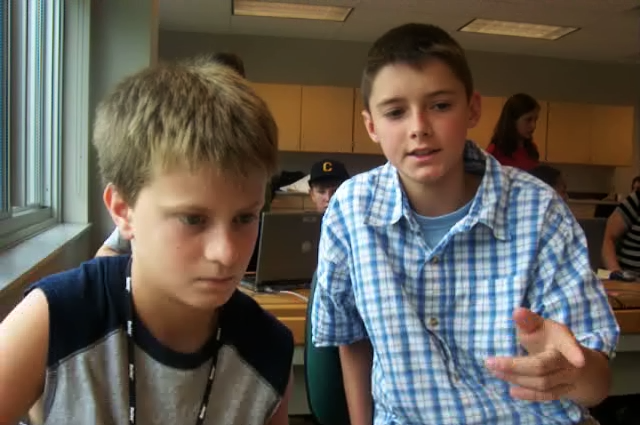
TechYES - Student Technology Literacy Certification Program
TechYES is a comprehensive technology training and certification solution for students in grades 6-9.
Features:
- All inclusive program
- Student-friendly guidebooks
- Comprehensive implementation guide
- Flexible implementation options
- Web Portal with engaging technology literacy curriculum, planning and assessment tools
- 3 stage certification process that is quick and easy to administer, track, and report
- National certification, local control
TechYES Starter Kit

The TechYES Starter Kit contains everything you need.
Download Implementation Guide Table of Contents and Sample Chapter (PDF)
Benefits:
- Designed to meet and exceed ISTE NETS Standards (2007 Refresh) for 6-8th grade students
- Meets NCLB mandate of 8th grade technology literacy for all
- Improves academic performance
- Creates a cost-effective, sustainable technology proficiency program for every student
- Does not require formal classroom instruction
- Project-based - incorporates individual student interests
- Different models of implementation
TechYES can be implemented in a variety of ways:
- In a technology elective
- As part of a required technology, career, or business application class
- In a core curriculum class
- As the basis for an after-school tech club or program
- As a gifted program
- As independent study
- As a spring break or summer tech camp
- For scout troops, home schools, churches, and other clubs
Program Logistics
How long does TechYES take?
Planning and completing two TechYES projects takes about 20 hours of time for the student to go through the process from start to finish. The basic tech literacy activities included in the Starter Kit require another 10 hours. More time may be required for students depending on their existing level of technology skill, access to computers at home, and how many peer mentors there are to assist individual students.
How many students can do TechYES?
That's completely up to you -- the Starter Kit contains materials for 30 students. If you want to have more students participate, you just purchase more Student Guides (see pricing page).
How can every student participate?
One way is to introduce TechYES at a single grade level so that students can participate both as students and Peer Mentors. For example, in a school with grades 6-8, 6th graders could do TechYES in a required technology class or a subject that all 6th graders have in common, such as science or social studies. Next year, some of these students can be Peer Mentors and assist incoming 6th graders. You can look to some of the 8th graders taking a leadership role as veteran Peer Mentors, or have them participate in a tech support team, school video production class, or take on other responsibilities.
What does a typical timeline look like for an after-school program?
Typically, an after-school timeline follows the school year, beginning with recruiting the students in the fall and ending at least a month before school ends to avoid running out of time.
If the students meet at least one hour a week, they can start in the fall by learning Internet safety and web critiquing skills in a few sessions. Before winter break, they can move on to learning about the technology available to them. After the winter break, they should decide on their first project in January, and complete it in February or March. After spring break, start on the second project and complete that by April or May. You will have to work around your specific breaks and testing, and leave extra time for snow days, students that miss a session, and other unexpected occurrences.
Some after-school programs start in January, and meet more often than once a week.
There are many more details on planning and implementing after-school TechYES programs in the Implementation Guide that comes as part of the TechYES Starter Kit.
What does a typical timeline look like if TechYES is part of a semester or year-long technology class?
As part of a daily course, TechYES projects can be assigned as course projects. There should be class time devoted to learning about the project criteria and introducing the Student Guide.
If the class meets every day, TechYES can be introduced part-way into the class as a way to assess student technology skills using the project structure found in the Student Guide. The TechYES process typically takes about 20 hours in addition to the time required for the basic TechYES tech literacy activities and application instruction. The TechYES Student Guide will help your students take their newly learned basic technology skills and combine them into projects that can support their other classes, meet community or service requirements, or are purely for personal satisfaction. Because it is flexible, TechYES can be a part of various timeframes and schedules, and work with any hardware, software, or operating system in use in the school.
There are many more details on planning, implementation, and assessment for in-class TechYES programs in the Implementation Guide that comes as part of the TechYES Starter Kit.
Can TechYES be the entire curriculum for a technology course?
Yes, the optional TechYES Technology Literacy Curriculum (TechYES TLC) contains many addtional technology literacy units that can be customized for any technology class. TechYES TLC offers several pathways that allow you to select the units and activities that work best for your students, your technology infrastructure, and your timeline. More details about TechYES TLC here.
Can I use my own curriculum?
Yes, if you have curriculum you already use for your technology class, you can combine it with the TechYES project process and certification. TechYES projects can become project assignments for the class. Teachers like TechYES because the Student Guide helps students understand the project process and gives students structure and clear objectives to work towards. We typically find that schools with their own basic technology curriculum start using TechYES mid-way through the semester.
It typically requires about 20 hours to complete the two TechYES projects, so this can be done in the second half of the semester, or done as homework if students have access. It may help to have a few lunch or after-school sessions where students can work on their projects for longer periods of time with support of peer mentors.
Can we do this as a quarter-long class or a rotation class?
Yes, TechYES can be used this way. Be sure to allow enough time for students to have time to work on their projects, work through frustrations, make mistakes and fix them. It may help to have a few lunch or after-school sessions where students can work on their projects for longer periods of time with support of peer mentors.
Several other teachers are requiring projects and we are able to combine our needs and the kids love talking about their ideas with each of their teachers. - TechYES Teacher |
All our technology is integrated into the curriculum. Can I do TechYES as part of a class like social studies?
Yes. By incorporating the TechYES project criteria into project requirements for the class, student projects can fulfill both criteria. Depending on the technology expertise of the teacher(s), you may want to partner with a technology specialist to come into the class to introduce available technology to the students. Peer mentors can also help students if available in class, in a tutoring center, or after-school.
In these cases, it makes a lot of sense to tie at least one of the projects into the class curriculum. Other ideas could be to have students create projects that teach the subject matter to younger students, create projects that could be put on a website for the community (such as a local history resource), or to connect projects into other school goals such as parent involvement (for example, by teaching family members how to use email.)
Can I require every student to do the same project?
This is not something we recommend. By giving the students choices, you increase student ownership and commitment to the project. Of course, you can allow creativity within guidelines. Allowing a variety of projects may seem like a lot of work, but this is why peer mentors are so important. One aspect of having a variety of projects is that students will learn from each other as they see each other creating and solving problems.
If you think that your students will not be able to complete a wide variety of projects, a compromise may be to assign the first project in a more structured way, and then allow more variability in the choice of a second project.
Can I require that projects all meet some goal (such as teaching math?)
Yes. Many TechYES programs are also meeting other school or district goals such as improving math/science, parent and family communication, community involvement, or others.
Projects can be completed in any language, as well -- another reason to find and train good peer mentors!
Can we do this in 5th grade (or in high school)?
TechYES has been run both with 5th graders and in an alternative high school setting. None of the materials specifically mention a grade level. The grade recommendation of grade 6-9 is mostly a reading level requirement. We would be happy to send you a sample Student Guide and you can judge whether this is a good fit for your students. Even if some students do not read at a 6th grade level, or are not fluent in English, the Peer Mentors can help meet the individual needs of students as they work on their projects.




